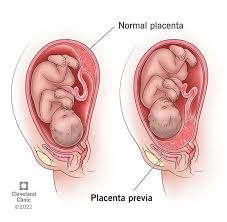A nurse is caring for a client who is 2 hours postpartum. The nurse notes that the client soaked a perineal pad in 10 minutes, the client's skin color is ashen, and she states she feels weak and lightheaded. After applying oxygen via nonrebreather face mask at 10 L/min, which of the following actions should the nurse take next?
Insert an indwelling urinary catheter.
Administer oxytocin by continuous IV infusion.
Massage the client's fundus to promote contractions.
Tilt the client onto her right side with her legs elevated to at least 30 degrees.
The Correct Answer is C
Choice A reason:
Inserting an indwelling urinary catheter can be helpful in measuring urine output and reducing bladder distention, which may impede uterine contractions. However, it is not the immediate next step in managing postpartum hemorrhage.
Choice B reason:
Administering oxytocin by continuous IV infusion is a standard intervention to promote uterine contractions after delivery, which helps to control bleeding. However, before starting an oxytocin infusion, it is important to ensure that there are no retained placental fragments and that the uterus is not already well-contracted.
Choice C reason:
Massaging the client's fundus is the priority action because it can stimulate uterine contractions, which are essential for controlling postpartum bleeding. A firm, contracted uterus helps to compress the blood vessels and prevent excessive bleeding.
Choice D reason:
Tilting the client onto her right side with her legs elevated can help improve venous return and may be part of the management for shock. However, the immediate concern in a postpartum client with excessive bleeding is to manage the bleeding by promoting uterine contractions.
Nursing Test Bank
Naxlex Comprehensive Predictor Exams
Related Questions
Correct Answer is C
Explanation
Choice A reason:
Precipitous labor is characterized by a labor that progresses rapidly and ends within three hours of its onset. It is not typically associated with painless, bright red vaginal bleeding. This condition is more likely to present with intense, frequent contractions and a rapid change in cervical dilation. Therefore, precipitous labor is not the correct answer in this scenario.
Choice B reason:
Abruptio placentae, also known as placental abruption, is a condition where the placenta detaches from the uterus before delivery. It can cause significant maternal and fetal complications. The classic presentation includes painful bleeding, uterine tenderness, and contractions. Given that the scenario describes painless bleeding, abruptio placentae is less likely to be the correct diagnosis.
Choice C reason:
Placenta previa is a condition where the placenta covers the cervix partially or completely. The hallmark sign of placenta previa is painless, bright red vaginal bleeding, which aligns with the scenario provided. This bleeding can occur spontaneously or be triggered by intercourse or a medical exam. Placenta previa is a serious condition that can lead to maternal and fetal hemorrhage and warrants immediate medical attention. Based on the information provided, placenta previa is the most likely diagnosis for the client described.
Choice D reason:
Threatened abortion refers to vaginal bleeding that occurs in the first 20 weeks of pregnancy, which may indicate a potential miscarriage. Since the client is at 36 weeks gestation, threatened abortion is not a relevant diagnosis for late-term bleeding. Additionally, threatened abortion is often accompanied by abdominal cramping, which is not mentioned in the scenario.

Correct Answer is B
Explanation
Choice a reason:
Mastitis is an infection of the breast tissue that results in pain, swelling, warmth, and redness. The symptoms of mastitis typically include breast tenderness, redness on the skin, breast pain, and sometimes fever and malaise. While the client's breasts are described as hard and warm, which could be associated with mastitis, the absence of other key symptoms such as fever or flu-like symptoms suggests that mastitis may not be the issue here.
Choice b reason:
Three days postpartum, it is normal for the fundus to be below the umbilicus and for lochia rubra to be present. The hardness and warmth of the breasts could be due to milk coming in, which is also a normal postpartum change. Without additional symptoms of concern, such as fever, severe pain, or signs of infection, it is reasonable to conclude that no additional interventions are required at this time.
Choice c reason:
Removing a nursing bra can provide comfort, especially if it is too tight and contributing to breast engorgement or clogged ducts. However, there is no indication that the client's nursing bra is causing an issue. Nursing bras are designed to support the breasts during breastfeeding and typically do not need to be removed unless they are causing specific problems.
Choice d reason:
Applying a heating pad can help with milk let-down and relieve discomfort from engorgement or clogged ducts. However, since the client is not exhibiting signs of mastitis or severe engorgement, and the warmth of the breasts may be due to normal postpartum changes, the application of a heating pad is not necessarily indicated at this time.
Whether you are a student looking to ace your exams or a practicing nurse seeking to enhance your expertise , our nursing education contents will empower you with the confidence and competence to make a difference in the lives of patients and become a respected leader in the healthcare field.
Visit Naxlex, invest in your future and unlock endless possibilities with our unparalleled nursing education contents today
Report Wrong Answer on the Current Question
Do you disagree with the answer? If yes, what is your expected answer? Explain.
Kindly be descriptive with the issue you are facing.
